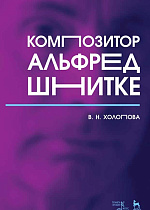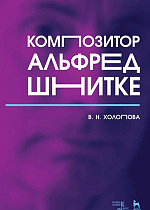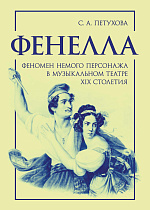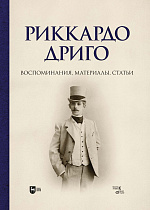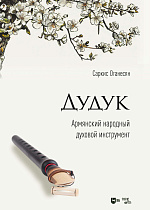История зарубежной музыки - все книги по дисциплине. Издательство Лань
Сохранить список:
Excel
Excel
Закрыть
Выгрузка списка книг доступна только авторизованным пользователям. Авторизоваться
Учебное пособие представляет собой обзор основных стилей и направлений музыки XX века, а также знакомит с творчеством и произведениями наиболее значительных зарубежных композиторов. Книга охватывает не только академическую музыку, но и затрагивает явления массовой культуры, джаза и мюзикла. Пособие содержит нотные примеры и словарь. В комплекте к учебному пособию прилагается аудиохрестоматия. Учебное пособие успешно прошло апробацию на исполнительских отделениях музыкальных средних учебных заведений. Предназначается для студентов музыкальных училищ и колледжей, преподавателей музыкальных и общеобразовательных школ, а также читателей, интересующихся современной музыкой.
Учебное пособие представляет собой обзор основных стилей и направлений музыки XX века, а также знакомит с творчеством и произведениями наиболее значительных зарубежных композиторов. Книга охватывает не только академическую музыку, но и затрагивает явления массовой культуры, джаза и мюзикла. Пособие содержит нотные примеры и словарь. В комплекте к учебному пособию прилагается аудиохрестоматия. Учебное пособие успешно прошло апробацию на исполнительских отделениях музыкальных средних учебных заведений. Предназначается для студентов музыкальных училищ и колледжей, преподавателей музыкальных и общеобразовательных школ, а также читателей, интересующихся современной музыкой.
Предлагаемое издание посвящено одной из важнейших постановок московского балетмейстера Александра Алексеевича Горского (1871–1924) — мимодраме «Дочь Гудулы». Она была показана в 1902 году и, несмотря на то что быстро сошла со сцены, в истории отечественного балета осталась не только как первое реформаторское произведение своего автора, но и как своего рода точка отсчёта преобразований в русском хореографическом театре.
Две части уникального издания одновременно и дополняют друг друга, и представляют самостоятельный интерес. Клавир мимодрамы впервые предлагается читателям, в исследовании даётся краткая история создания и сценической жизни постановки и подробно анализируется музыка «Дочери Гудулы» — та составляющая спектакля, которая способна сохраняться вне зависимости от прошедшего со времени премьеры времени.
Издание будет интересно теоретикам и практикам балета, музыковедам, культурологам и всем любителям музыкального театра.
The current edition is devoted to the mime drama Gudula’s Daughter, one of the most important productions by Alexander Alexeevich Gorsky (1871–1924), the Moscow ballet master. It was first shown in 1902 and, despite the fact that it quickly disappeared from stage, it remained in the Russian ballet history not only as the first innovative work of its author, but also as a kind of a starting point for transformations in the Russian choreographic theater.
Two parts of this unique edition complement each other and are at the same time of independent interest. The piano score of the mime drama is published for the first time, the study provides a brief history of the creation and stage life of the production and analyzes in detail the music of the Gudula’s Daughter, that part of the performance that can continue to exist regardless of the time that has passed since the premiere.
The edition will be of interest to ballet theorists and practitioners, musicologists, culture experts and all the music theater lovers.
Две части уникального издания одновременно и дополняют друг друга, и представляют самостоятельный интерес. Клавир мимодрамы впервые предлагается читателям, в исследовании даётся краткая история создания и сценической жизни постановки и подробно анализируется музыка «Дочери Гудулы» — та составляющая спектакля, которая способна сохраняться вне зависимости от прошедшего со времени премьеры времени.
Издание будет интересно теоретикам и практикам балета, музыковедам, культурологам и всем любителям музыкального театра.
The current edition is devoted to the mime drama Gudula’s Daughter, one of the most important productions by Alexander Alexeevich Gorsky (1871–1924), the Moscow ballet master. It was first shown in 1902 and, despite the fact that it quickly disappeared from stage, it remained in the Russian ballet history not only as the first innovative work of its author, but also as a kind of a starting point for transformations in the Russian choreographic theater.
Two parts of this unique edition complement each other and are at the same time of independent interest. The piano score of the mime drama is published for the first time, the study provides a brief history of the creation and stage life of the production and analyzes in detail the music of the Gudula’s Daughter, that part of the performance that can continue to exist regardless of the time that has passed since the premiere.
The edition will be of interest to ballet theorists and practitioners, musicologists, culture experts and all the music theater lovers.
Сборник статей «От Русалки до Иоланты» посвящен различным аспектам истории музыки. В разделе «Музыка и литература» рассматриваются характеристики фольклорных и литературных персонажей в музыкальных и литературных сочинениях. Ценным дополнением к статьям являются таблицы, основанные на многочисленных примерах из русской и зарубежной музыки. Раздел «Специфика музыкального языка» посвящен семантике солирующих тембров в операх, семан-тике тональностей, проблеме «цветного слуха». Раздел «История музыки» представляет исследования о зарубежных музыкантах, посетивших Санкт-Петербург в первой половине XIX в. В «Методических аспектах преподавания истории музыки» предлагаются варианты изучения оперы на уроках истории музыки в музыкальных училищах.
Соответствует современным требованиям Федерального государственного образовательного стандарта среднего профессионального образования и профес-сиональным квалификационным требованиям. Книга адресована педагогам и средних специальных учебных заведений.
The collection of articles From the Mermaid to Iolanta is devoted to various sides of the music history. In the Music and Literature section the characteristics of folklore and literary characters in musical and literary works are examined. A valuable addition to the articles are the tables with numerous examples from Russian and foreign music. The Specifics of Musical Language section is devoted to the semantics of solo timbres in operas, the semantics of keys, and the issue of “color hearing”. The Music History section presents the study on foreign musicians who visited St. Petersburg in the first half of the 19th century. The Methodological Aspects of Teaching the Music History offers options for studying opera at music history lessons at music colleges.
Corresponds to the modern requirements of the Federal State Educational Standard of Secondary Vocational Education and professional qualification requirements. The book is addressed to teachers and students of colleges.
Соответствует современным требованиям Федерального государственного образовательного стандарта среднего профессионального образования и профес-сиональным квалификационным требованиям. Книга адресована педагогам и средних специальных учебных заведений.
The collection of articles From the Mermaid to Iolanta is devoted to various sides of the music history. In the Music and Literature section the characteristics of folklore and literary characters in musical and literary works are examined. A valuable addition to the articles are the tables with numerous examples from Russian and foreign music. The Specifics of Musical Language section is devoted to the semantics of solo timbres in operas, the semantics of keys, and the issue of “color hearing”. The Music History section presents the study on foreign musicians who visited St. Petersburg in the first half of the 19th century. The Methodological Aspects of Teaching the Music History offers options for studying opera at music history lessons at music colleges.
Corresponds to the modern requirements of the Federal State Educational Standard of Secondary Vocational Education and professional qualification requirements. The book is addressed to teachers and students of colleges.
Сборник статей «От Русалки до Иоланты» посвящен различным аспектам истории музыки. В разделе «Музыка и литература» рассматриваются характеристики фольклорных и литературных персонажей в музыкальных и литературных сочинениях. Ценным дополнением к статьям являются таблицы, основанные на многочисленных примерах из русской и зарубежной музыки. Раздел «Специфика музыкального языка» посвящен семантике солирующих тембров в операх, семантике тональностей, проблеме «цветного слуха». Раздел «История музыки» представляет исследования о зарубежных музыкантах, посетивших Санкт-Петербург в первой половине XIX в. В «Методических аспектах преподавания истории музыки» предлагаются варианты изучения различных произведений на уроках истории музыки в музыкальных училищах.
Для музыкантов-профессионалов, педагогов и студентов средних и высших музыкальных учебных заведений.
The collection of articles From the Mermaid to Iolanta is devoted to various sides of the music history. In the Music and Literature section the characteristics of folklore and literary characters in musical and literary works are examined. A valuable addition to the articles are the tables with numerous examples from Russian and foreign music. The Specifics of Musical Language section is devoted to the semantics of solo timbres in operas, the semantics of keys, and the issue of “color hearing”. The Music History section presents the study on foreign musicians who visited St. Petersburg in the first half of the 19th century. The Methodological Aspects of Teaching the Music History offers options for studying different works at music history lessons at music colleges.
For professional musicians, teachers and students of music colleges and higher schools.
Для музыкантов-профессионалов, педагогов и студентов средних и высших музыкальных учебных заведений.
The collection of articles From the Mermaid to Iolanta is devoted to various sides of the music history. In the Music and Literature section the characteristics of folklore and literary characters in musical and literary works are examined. A valuable addition to the articles are the tables with numerous examples from Russian and foreign music. The Specifics of Musical Language section is devoted to the semantics of solo timbres in operas, the semantics of keys, and the issue of “color hearing”. The Music History section presents the study on foreign musicians who visited St. Petersburg in the first half of the 19th century. The Methodological Aspects of Teaching the Music History offers options for studying different works at music history lessons at music colleges.
For professional musicians, teachers and students of music colleges and higher schools.
Книга посвящена одному из крупнейших композиторов XX века Альфреду Гарриевичу Шнитке (1934-1998).
Книга адресована как музыкантам-профессионалам, так и широкому кругу читателей, интересующихся художественной культурой XX века.
Книга адресована как музыкантам-профессионалам, так и широкому кругу читателей, интересующихся художественной культурой XX века.
Книга посвящена одному из крупнейших композиторов XX века Альфреду Гарриевичу Шнитке (1934-1998).
Книга адресована как музыкантам-профессионалам, так и широкому кругу читателей, интересующихся художественной культурой XX века.
Книга адресована как музыкантам-профессионалам, так и широкому кругу читателей, интересующихся художественной культурой XX века.
Настоящая книга является первой попыткой рассмотрения феномена немого персонажа в оперном театре романтического XIX века. Главное место в исследовании занимает образ Фенеллы — титульной роли в опере Даниэля Обера и Эжена Скриба «Немая из Портичи» (1828), созданной для пантомимной солистки. Некогда это сочинение имело фантастическую популярность, а безмолвная партия становилась предметом конкуренции артисток разного амплуа: балерин и мимисток, драматических актрис и певиц. История постановок оперы на Западе и в России базируется на подробностях биографий этих исполнительниц, их взаимоотношений, пристрастий и интерпретаций.
Книга снабжена иллюстрациями и развёрнутыми приложениями, помогающими ориентироваться в театральном мире ушедших времён. Издание предназначено для специалистов театра и музыки, а также для всех, кто любит балетное искусство.
The current book is the first attempt to study the phenomenon of a mute character in the romantic 19th century opera theatre. The main place in the study belongs to the Fenella image, the title role in “La Muette de Portici” (“The Mute Girl of Portici”, 1828), the opera by Daniel Auber and Eugène Scribe, created for a solo pantomime performer. The piece used to be incredibly popular, and the mute part became the subject of competition between artists of a different type: ballet dancers and mime artists, drama actresses and singers. The history of the opera’s productions in the West and in Russia is based on these performers’ biographical moments, their relationships, sympathies and interpretations.
The book is illustrated and provided with detailed appendices, aimed to help readers understand the theatrical world of bygone times. The edition is intended for theatre and music experts, as well as for all music theatre lovers.
Книга снабжена иллюстрациями и развёрнутыми приложениями, помогающими ориентироваться в театральном мире ушедших времён. Издание предназначено для специалистов театра и музыки, а также для всех, кто любит балетное искусство.
The current book is the first attempt to study the phenomenon of a mute character in the romantic 19th century opera theatre. The main place in the study belongs to the Fenella image, the title role in “La Muette de Portici” (“The Mute Girl of Portici”, 1828), the opera by Daniel Auber and Eugène Scribe, created for a solo pantomime performer. The piece used to be incredibly popular, and the mute part became the subject of competition between artists of a different type: ballet dancers and mime artists, drama actresses and singers. The history of the opera’s productions in the West and in Russia is based on these performers’ biographical moments, their relationships, sympathies and interpretations.
The book is illustrated and provided with detailed appendices, aimed to help readers understand the theatrical world of bygone times. The edition is intended for theatre and music experts, as well as for all music theatre lovers.
В предлагаемой книге собраны документы, статьи и материалы, посвященные жизни и творчеству Риккардо Дриго (1846-1930). Итальянский композитор и дирижер, более сорока лет служивший капельмейстером оркестра сначала итальянской оперной, затем балетной труппы Императорских театров Петербурга, он оставил значительный след в истории русского музыкального театра. Сведений о его жизни и работе в России сохранилось немного, и даже они оказались разрозненны по архивам и музеям разных городов страны. В данной книге предпринята попытка собрать воедино документы, исследования, воспоминания и различные материалы, имеющие отношение к Р. Дриго, а также программы и либретто его сочинений.
Книга адресована специалистам в области искусствознания (музыковедам, балетоведам, историками театра и культурологам) и всем интересующимся историей музыкального театра рубежа XIX–XX вв.
The current book contains documents, articles and materials devoted to the life and work of Riccardo Drigo (1846–1930). An Italian composer and conductor who served for over forty years as the kappelmeister, first of the Italian opera and later of the St. Petersburg Imperial Theatres ballet troupe, he left a significant mark in the Russian music theatre history. Little in-formation about his life and work in Russia has survived, and even that information is scattered across archives and museums in the country’s various cities. This book attempts to bring together documents, research, recollections and various materials related to R. Drigo, as well as programs and librettos of his works. The book is addressed to specialists in the field of art history (musicologists, ballet historians, theatre historians and cultural experts) and to all those interested in the history of music theatre at the turn of the 19th and 20th centuries.
Книга адресована специалистам в области искусствознания (музыковедам, балетоведам, историками театра и культурологам) и всем интересующимся историей музыкального театра рубежа XIX–XX вв.
The current book contains documents, articles and materials devoted to the life and work of Riccardo Drigo (1846–1930). An Italian composer and conductor who served for over forty years as the kappelmeister, first of the Italian opera and later of the St. Petersburg Imperial Theatres ballet troupe, he left a significant mark in the Russian music theatre history. Little in-formation about his life and work in Russia has survived, and even that information is scattered across archives and museums in the country’s various cities. This book attempts to bring together documents, research, recollections and various materials related to R. Drigo, as well as programs and librettos of his works. The book is addressed to specialists in the field of art history (musicologists, ballet historians, theatre historians and cultural experts) and to all those interested in the history of music theatre at the turn of the 19th and 20th centuries.
В Ваших руках уникальное издание, посвященное полюбившемуся во всем мире музыкальному инструменту – армянскому дудуку. В основе книги – многолетние научные исследования музыковеда, кандидата искусствоведения, композитора, педагога Саркиса Эмильевича Оганесяна. В своей работе автор подробно рассматривает историю инструмента, технологию его изготовления, особенности конструкции и тембра. Разбираются тонкости исполнительского мастерства, создания академической и киномузыки для дудука. Особое внимание уделяется исследованиям лечебных свойств его тембра, воздействию частот инструмента на организм человека. Книга содержит иллюстрации, фотографии, чертежи с изображением дудука, а также QR-коды со ссылками на исполнения мастеров дудукистов, беседы с легендарными музыкантами и др., что в свою очередь, обещает сделать чтение не только информативным, но и увлекательным.
Книга адресована музыковедам, музыкантам и широкому кругу читателей.
Here you have a unique edition devoted to the world-famous musical instrument — the Armenian duduk. The book is the result of many years of scientific research by Sarkis Emilievich Oganesyan, the musicologist, art history PhD, composer and educator. In his work, the author thoroughly examines the instrument history, its manufacturing technology, design features and timbre. He also studies the nuances of performing skills and creating academic and film music for duduk. A particular attention is paid to research into the healing possibilities of its timbre, the impact of the instrument’s frequencies on the human body. The book contains illustrations, photographs, drawings of the duduk, as well as QR codes with links to performances by duduk maestros, conversations with legendary musicians, etc., which in turn promises to make reading not only informative, but also fascinating.
The book is addressed to musicologists, musicians and a wide range of readers.
Книга адресована музыковедам, музыкантам и широкому кругу читателей.
Here you have a unique edition devoted to the world-famous musical instrument — the Armenian duduk. The book is the result of many years of scientific research by Sarkis Emilievich Oganesyan, the musicologist, art history PhD, composer and educator. In his work, the author thoroughly examines the instrument history, its manufacturing technology, design features and timbre. He also studies the nuances of performing skills and creating academic and film music for duduk. A particular attention is paid to research into the healing possibilities of its timbre, the impact of the instrument’s frequencies on the human body. The book contains illustrations, photographs, drawings of the duduk, as well as QR codes with links to performances by duduk maestros, conversations with legendary musicians, etc., which in turn promises to make reading not only informative, but also fascinating.
The book is addressed to musicologists, musicians and a wide range of readers.







